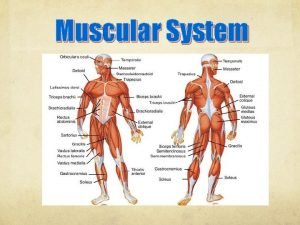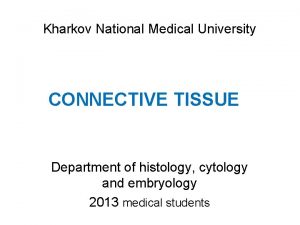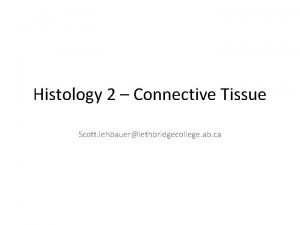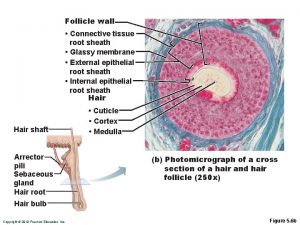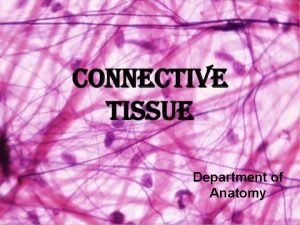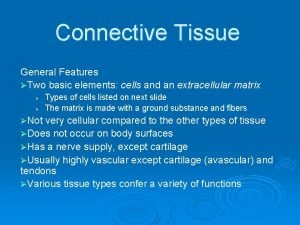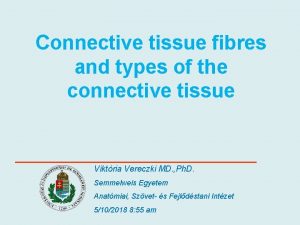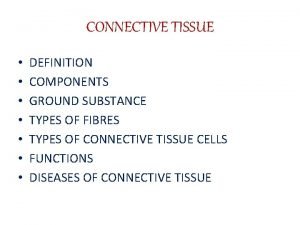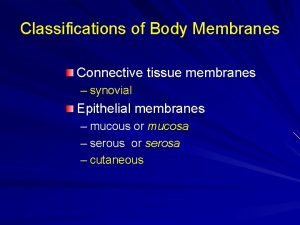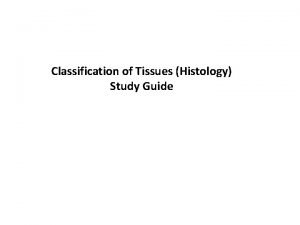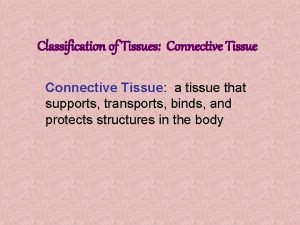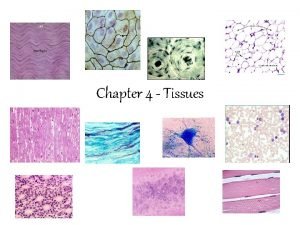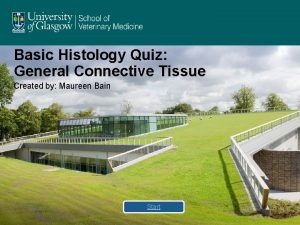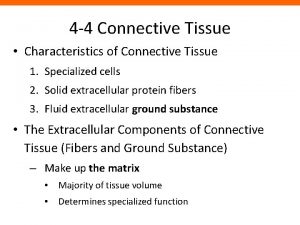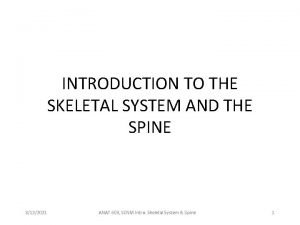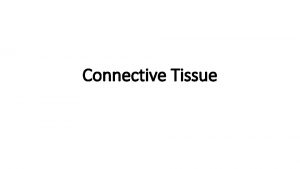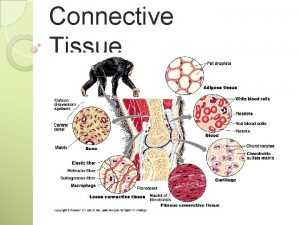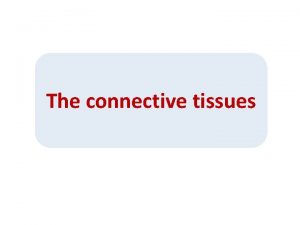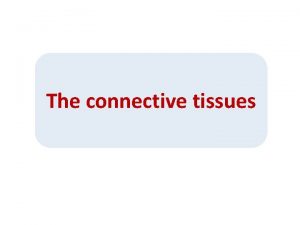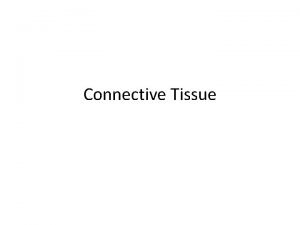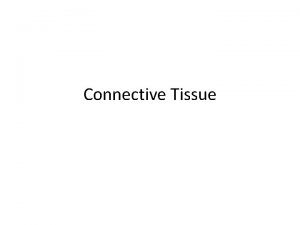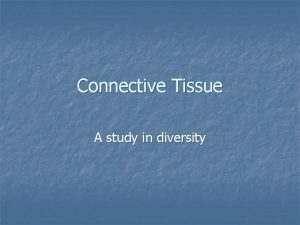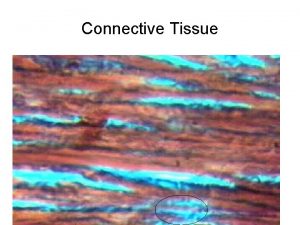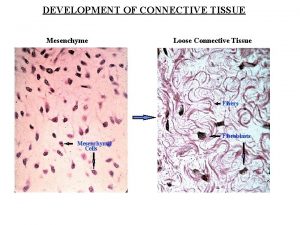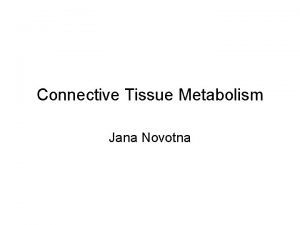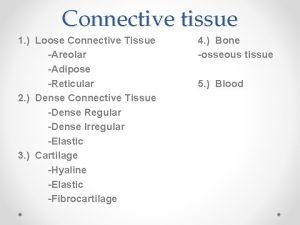Connective Tissue Functions Connects Muscles to muscles Muscles





















- Slides: 21

Connective Tissue • Functions – Connects • Muscles to muscles • Muscles to bone • Bones to bones – Supports – Transports • Large array of substances between parts of the body – Defends • Against microorganisms and other invaders

Connective Tissue • General characteristics – Extracellular matrix (ECM) predominates in most connective tissues and determines its physical characteristics – Relatively few cells – Ground substance – Varying numbers and kinds of fibers • Collagenous (white) – Tough and strong, great tensile strength – Made of collagen fibers, often in bundles • Reticular – Occur in networks – Delicate and support small structures – Made of reticulin • Elastic – Made of elastin – Extensible and elastic

Connective Tissue • Four main types – Fibrous • Loose, ordinary (areolar) • Adipose • Reticular • Dense – Irregular – Regular (collagenous and elastic) – Bone • Compact bone • Cancellous bone – Cartilage • Hyaline • Fibrocartilage • Elastic – Blood

Connective Tissue • Fibrous connective tissue – Loose, ordinary (areolar) connective tissue (Figure 5 -13) • • Stretchable One of the most widely distributed of all tissues Elastic glue that permits movement Intercellular substance is prominent and consists of collagenous and elastic fibers loosely interwoven and embedded in soft, viscous ground substance • Several kinds of cells present: notably, fibroblasts and macrophages; also mast cells, plasma cells, fat cells, and some white blood cells • Function—stretchy, flexible connection

Loose, Ordinary (Areolar) Connective Tissue

Connective Tissue • Adipose tissue (Figures 5 -14 and 5 -15) – Similar to loose connective tissue but contains mainly fat cells, fewer fibroblasts, macrophages, and mast cells – Functions—protection, insulation, support, and food reserve

Connective Tissue • Reticular tissue (Figure 5 -16) – Consists of network of branching reticular fibers with reticular cells overlying them – Functions • Defense against microorganisms and other injurious substances • Reticular meshwork filters out injurious particles from the blood and lymph, and reticular cells phagocytose them • Make reticular fibers – Forms framework of spleen, lymph nodes, and bone marrow

Reticular Tissue

Connective Tissue • Dense fibrous tissue – Matrix consists mainly of fibers packed densely and relatively few fibroblast cells • Regular—bundles of fibers are arranged in regular, parallel rows (Figure 5 -17) – Predominantly collagen: flexible, great tensile strength (tendons) – Predominantly elastic fibers: some elasticity (ligaments) • Irregular—fibers intertwine irregularly to form a thick mat that can withstand stresses applied form any direction (Figure 5 -19) – Forms the strong inner skin layer called the dermis – Forms the outer capsule of the kidneys and spleen – Function—furnishes flexible connections that are strong or stretchy

Dense Fibrous (Regular) Connective Tissue

Connective Tissue • Bone (osseous) tissue – Highly specialized connective tissue type • Cells—osteocytes—embedded in a matrix consisting of organic collagen material and mineral salts • Inorganic component of matrix accounts for 65% of total bone tissue – Functions: • Support • Protection • Point of attachment for muscles • Reservoir for minerals • Supports blood-forming tissue

Connective Tissue • Compact bone (Figures 5 -20) – Osteon (Haversian system) • • Structural unit of bone Spaces for osteocytes called lacunae Matrix present in concentric rings called lamellae Canaliculi are canals that join lacunae with the central Haversian canal – Cell types: • Osteocyte: mature, inactive bone cell • Osteoblast: active, bone-forming cell • Osteoclast: bone-destroying cell – Formation (ossification) • In membranes—e. g. , flat bones of skull • From cartilage (endochondral)—e. g. , long bones, such as the humerus

Bone

Connective Tissue • Cartilage – Chondrocyte is only cell type present • Produce the fibers and ground substance – Lacunae house cells, as in bone – Avascular • Nutrition of cells depends on diffusion of nutrients through matrix – Perichondrium is the membrane that surrounds cartilage – Heals slowly after injury because of slow nutrient transfer to the cells

Connective Tissue • Types – Hyaline (Figure 5 -21) • Appearance is shiny and translucent • Most prevalent type of cartilage • Located on the ends of articulating bones

Connective Tissue • Types – Fibrocartilage (Figure 5 -22) • • Strongest and most durable type of cartilage Matrix is semirigid and filled with strong, white fibers Found in intervertebral disks and pubic symphysis Serves as shock-absorbing material between bones at the knee (menisci)

Connective Tissue • Types – Elastic (Figure 5 -23) • Contains many fine, elastic fibers • Provides strength and flexibility • Located in external ear and larynx

Connective Tissue • Blood – A liquid tissue (Figure 5 -24) – Contains neither ground substance nor fibers – Composition of whole blood • Liquid fraction (plasma) is the matrix – 55% of total blood volume • Formed elements – – 45% of total blood volume Red blood cells, erythrocytes White blood cells, leukocytes Platelets, thrombocytes

Connective Tissue • Blood (cont. ) – Functions • Transportation – Respiratory gases – Nutrients – Waste products • Regulation of body temperature • Regulation of body p. H • White blood cells destroy bacteria – Circulating blood tissue is formed in the red bone marrow by a process called hematopoiesis • Blood-forming tissue is sometimes called hematopoietic tissue

Blood

Muscle Tissue • Types (Table 5 -7) – Skeletal, or striated voluntary (Figure 5 -32) – Smooth, or nonstriated involuntary, or visceral (Figures 5 -33 and 5 -34) – Cardiac, or striated involuntary (Figure 5 -35) • Microscopic characteristics – Skeletal muscle—threadlike cells with many cross striations and many nuclei per cell – Smooth muscle—elongated, narrow cells, no cross striations, one nucleus per cell – Cardiac muscle—branching cells with intercalated disks (formed by abutment of plasma membranes of two cells)
 Dense connective tissue location and function
Dense connective tissue location and function Tissue that connects muscle to bone
Tissue that connects muscle to bone Connective tissue specialized
Connective tissue specialized Nervous tissue
Nervous tissue Fibrocytes
Fibrocytes Function hyaline cartilage
Function hyaline cartilage Dermal papilla
Dermal papilla Tissue type
Tissue type What tissue is this
What tissue is this Two basic elements of connective tissue
Two basic elements of connective tissue Dense regular connective tissue
Dense regular connective tissue Connective tissue components
Connective tissue components Blood cells
Blood cells Composition of connective tissue
Composition of connective tissue Serous mucous synovial and cutaneous membranes
Serous mucous synovial and cutaneous membranes Function
Function Where is adipose connective tissue found
Where is adipose connective tissue found Regular connective tissue
Regular connective tissue Connective tissue histology quiz
Connective tissue histology quiz Supporting connective tissue
Supporting connective tissue Characteristic of connective tissue
Characteristic of connective tissue Embryonic connective tissue
Embryonic connective tissue

